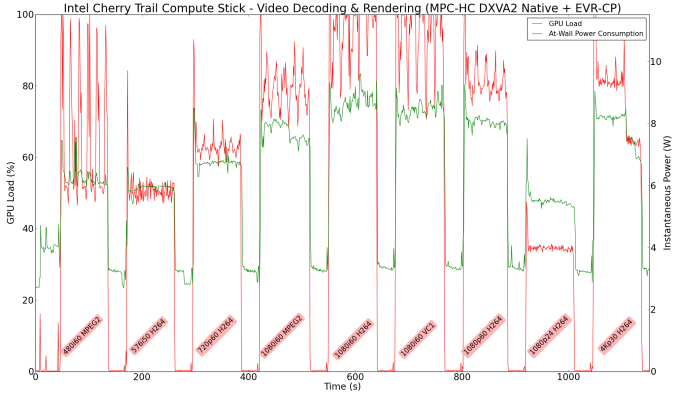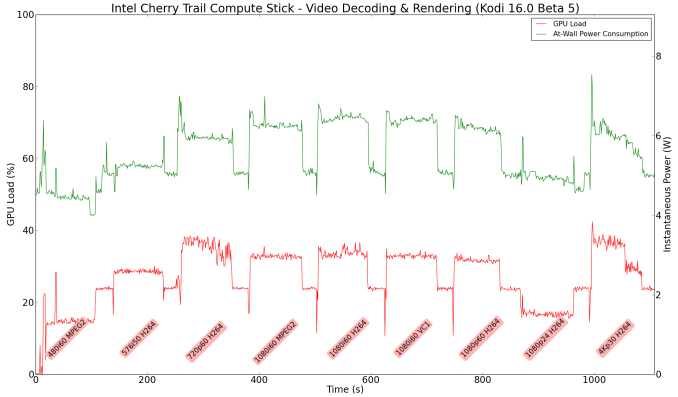The Intel Compute Stick (Cherry Trail) Review
by Ganesh T S on January 14, 2016 8:00 AM EST- Posted in
- Systems
- Intel
- Cherry Trail
- HDMI Stick
- CES 2016
- Compute Stick
HTPC Credentials
Usage of the Compute Stick as an entertainment platform is promoted by Intel as one of the use-cases. It is a bit surprising (given the form factor) that the Compute Stick has a fan. In this aspect, the Cherry Trail unit is no different from the Bay Trail unit. Subjectively, I was not comfortable with the acoustics in a 'office scenario' with the Compute Stick at the base of the monitor (connected via the HDMI extender cable) and myself seated around 70 cms. from it. The small diameter of the fan makes for a whining high-pitched noise, and it is compounded by the fact that it starts and stops depending on the SoC load.
Objectively speaking, Intel provided an acoustics rating of 28 dB at 1m distance for the noisiest mode. If the Compute Stick were to be hidden behind the TV, it is unlikely that users can hear such low noise at typical television viewing distances. It is not ideal, but Intel indicated that the performance of the device needs proper thermals. In order to to balance the very small size along with overall cost and performance, they decided to retain a small fan as the optimal thermal solution. Now that we have got the acoustics out of the way, let us move on to the other HTPC aspects.
Refresh Rate Accurancy
Starting with Haswell, Intel, AMD and NVIDIA have been on par with respect to display refresh rate accuracy. The most important refresh rate for videophiles is obviously 23.976 Hz (the 23 Hz setting). As expected, the Intel PPSTK1AW32SC has no trouble with refreshing the display appropriately in this setting. It actually performs better than the Bay Trail unit in this respect.
The gallery below presents some of the other refresh rates that we tested out. The first statistic in madVR's OSD indicates the display refresh rate.
Network Streaming Efficiency
Evaluation of OTT playback efficiency was done by playing back our standard YouTube test stream and five minutes from our standard Netflix test title. Using HTML5, the YouTube stream plays back a 720p encoding. Since YouTube now defaults to HTML5 for video playback, we have stopped evaluating Adobe Flash acceleration. Note that only NVIDIA exposes GPU and VPU loads separately. Both Intel and AMD bundle the decoder load along with the GPU load. The following two graphs show the power consumption at the wall for playback of the HTML5 stream in Mozilla Firefox (v 43.0.4).

GPU load was around 37.44% for the YouTube HTML5 stream and 11.14% for the steady state 6 Mbps Netflix streaming case.
Netflix streaming evaluation was done using the Windows 10 Netflix app. Manual stream selection is available (Ctrl-Alt-Shift-S) and debug information / statistics can also be viewed (Ctrl-Alt-Shift-D). Statistics collected for the YouTube streaming experiment were also collected here. While YouTube was more power efficient on the Cherry Trail Compute Stick, the Netflix case is the other way round. However, the numbers taken standalone do point to the Compute Stick units being a very power efficient platform for OTT streaming.

Decoding and Rendering Benchmarks
The form factor of the Compute Stick and the internal components make it clear that consumers are not going to play back videos using the madVR renderer. Instead, it is highly likely that Kodi will be used as the interface for media playback. We evaluated performance under MPC-HC + EVR-CP and Kodi 16.0 (Beta 5) for our test suite. Prior to those results, let us take a look at the codecs that are hardware-accelerated by the Cherry Trail SoC.
As expected, we have acceleration for MPEG-2, VC1, WMV9 and H.264. Interestingly, we also have support for HEVC (8-bit) and VP9 hardware-accelerated decoding in the upgraded GPU.
In our earlier reviews, we focused on presenting the GPU loading and power consumption at the wall in a table (with problematic streams in bold). Starting with the Broadwell NUC review, we decided to represent the GPU load and power consumption in a graph with dual Y-axes. Nine different test streams of 90 seconds each were played back with a gap of 30 seconds between each of them. The characteristics of each stream are annotated at the bottom of the graph. Note that the GPU usage is graphed in red and needs to be considered against the left axis, while the at-wall power consumption is graphed in green and needs to be considered against the right axis.
Frame drops are evident whenever the GPU load consistently stays above the 85 - 90% mark. In addition to tracking that aspect in the graphs below, we also get an idea of the system's power efficiency for decode and playback of some common codecs.
The above graph suggests that the Compute Stick is likely to drop frames when deinterlacing of high frame rate content is required. It is possible that EVR, the native renderer, will perform better than EVR-CP.
Kodi doesn't deinterlace content by default - so, the GPU load never goes unreasonably high. In the Bay Trail Compute Stick, Kodi struggled with the 1080i60 streams. Another aspect to observe with Kodi is that 'idling' at the XBMC interface consumes around 25% of the GPU resources and the power penalty is around 5 W. Depending on the codec and frame rate, the GPU load and power consumption might be lower or higher than the 'idle' state. For example, 480i60 and 1080p24 videos play back within the 5 W power envelop.
Note on HD Audio Bitstreaming
As of January 2016, the Intel graphics drivers for Cherry Trail (32-bit) have support only for bitstreaming of DTS, Dolby Digital and Dolby Digital Plus. This means that Netflix and other similar OTT sites are in the clear. However, users hoping to take advantage of lossless HD audio in Blu-ray backups are going to be disappointed. However, given the other limitations of the form factor and the system, it is unlikely that the absence of HD audio bitstreaming will bother too many consumers.




















80 Comments
View All Comments
mabsark - Thursday, January 14, 2016 - link
I'm got a Brix 1900 mini PC which I use as a HTPC / Plex Media Server. It's got 4 GB of RAM and a 30 GB SSD. It runs Windows 10, Kodi and Plex Media Server. There's still about 6 GB free. All the media is stored on my NAS so the HTPC doesn't need more storage.Compute Sticks are basically streaming devices. You're not going to be installing a load of apps or media on them so they don't really need much storage space.
BrokenCrayons - Friday, January 15, 2016 - link
You do have a good argument, but my days of running in home servers and/or NAS units are long over. I don't want to deal with the hassle of being a systems administrator for my spouse and kids when all I really want my computers to do are provide connectivity, data processing, and entertainment at minimal operating overhead (power, space, heat & cooling, and time invested). That means ANY computer coming in the door needs to meet a certain set of criteria in painlessness of operation. 32GB of storage on a Windows box creates more problems than it solves and makes the Compute Stick a poor general purpose computing device. In my case, I don't deal with streaming media much except for the occasional YouTube clip or an Amazon video rental so the "everything else" a Compute Stick can do (or any other computer for that matter) is far more important than video playback and those other purposes do require a little more flash and, ideally, a couple more gigabytes of RAM.mabsark - Friday, January 15, 2016 - link
Beyond media and web browsing, what else would you be doing on such a weak system? If you need the functionality of a proper PC then you buy a proper PC, not something like a compute stick.The same applies to your HP Stream 11 which is clearly billed as a "cloud computer". Basically, you're looking at the wrong type of products for your needs and then complaining that they're not good enough. You may as well be complaining that it's unable to run the latest AA games at 4K.
BrokenCrayons - Friday, January 15, 2016 - link
My TRS-80 packing a 1.7MHz Zilog Z80 could play games and run a word processor without storage capacity problems. I don't see why 35 years later, a budget PC with a general purpose x86 processor shouldn't be expected to do much, much better. Besides that, the price difference between 32 and 64GB of solid state memory is insignificant, even given the relative cost of the rest of the platform. It's a perfectly valid complaint.Reflex - Friday, January 15, 2016 - link
A budget PC nowadays does much, much more than your TRS-80 ever did. Granted, more is better, but the comparison you are making is ridiculous.Lord of the Bored - Saturday, January 16, 2016 - link
Man, I'm still fighting to get the "instant-on" of my old 99/4a on a modern system. But at least boot times are starting to come back down. That's progress!doggface - Tuesday, January 19, 2016 - link
this argument is the worst. You could probably still play those games, and they would work a lot better. but not new games. and i bet your TRS-80 cost a bit more than $200 too.Completely different device. If you are looking to do anything more strenuous than basic internet or streaming.. you are barking up the wrong tree.
BrokenCrayons - Thursday, January 21, 2016 - link
"Completely different device. If you are looking to do anything more strenuous than basic internet or streaming.. you are barking up the wrong tree"That makes no sense at all to me. Cherry Trail systems have vastly more compute power than systems of not so long ago that were fully functional computers (ala 100MHz Pentiums, and TRS-80s). Given their immense computational capacity, there's no reason at all to intentionally limit the usage of such hardware to only a small subset of tasks billions of computers that came before it did perfectly fine with far more limited resources. It's a desktop PC in a small case and therefore it should be accordingly expected to handle any and all desktop PC chores a user requires so they don't need to waste money/time/space/effort buying a Compute Stick only to have to purchase an additional computer in one of many absurdly large, obsolete ATX-derived form factors.
Gunbuster - Thursday, January 14, 2016 - link
Does this work on a 4K TV at 4K resolution? Pretty much useless if it doesn't IMHO...dsraa - Thursday, January 14, 2016 - link
That's not what it's designed for.....